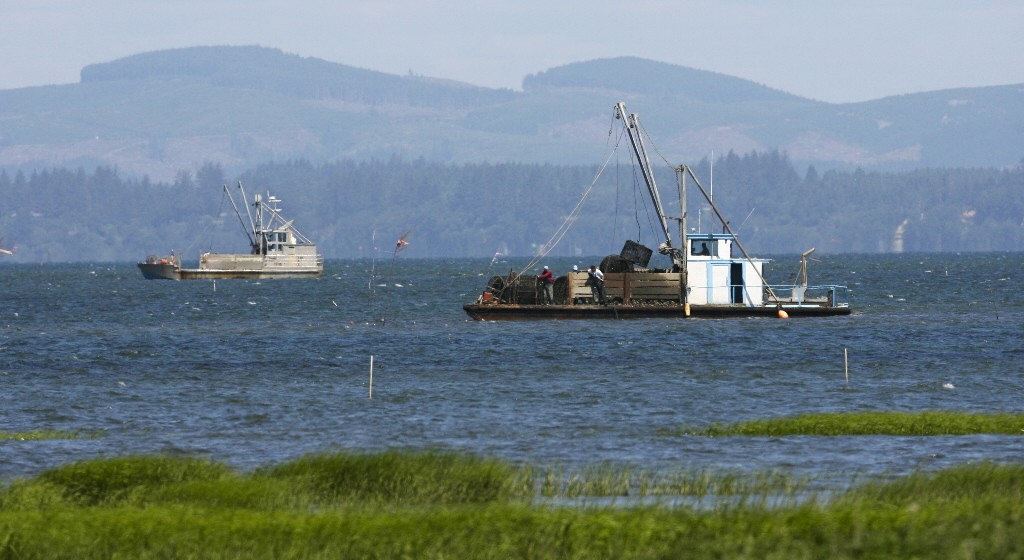05
May
Plans to Spray Toxic Insecticide in Washington Bays Are Canceled
(Beyond Pesticides, May 5, 2015) In a major victory for the environment and health, the Washington state Department of Ecology (Ecology) and oyster growers association agreed to withdraw a permit allowing the use of the neonicotinoid insecticide imidacloprid to control burrowing shrimp in oyster beds in Willapa Bay and Grays Harbor. The decision was reached in large part due to vocal public outrage over the plan, as consumers, environmental organizations, and prominent local chefs spoke out against the spraying.
 “One of our agency’s goals is to reduce toxics in our environment,” said Ecology Director Maia Bellon in a News Release published by the agency over the weekend. “We’ve heard loud and clear from people across Washington that this permit didn’t meet their expectations, and we respect the growers’ response.”
“One of our agency’s goals is to reduce toxics in our environment,” said Ecology Director Maia Bellon in a News Release published by the agency over the weekend. “We’ve heard loud and clear from people across Washington that this permit didn’t meet their expectations, and we respect the growers’ response.”
In an article published in the Seattle Times Friday, the largest shellfish producer in country, Taylor Shellfish, announced it will not treat its oyster beds with imidacloprid in response to numerous calls, emails, and social media comments made by its customers. “Our customers spoke loud and clear today, and that speaks volumes to us,” said Bill Dewey, spokesman for Taylor Shellfish. Given Taylor Shellfish’s size, it is likely that the Willapa/Grays Harbor Oyster Growers Association (WGHOGA) did not have the resources to move forward with the pesticide application.
“We believe we have no choice but to withdraw our permit and address these issues to the satisfaction of our customer base, and the public,” said Don Gillies, president of the WGHOGA, in the letter requesting withdrawal of the permit.
Imidacloprid is a systemic, neonicotinoid class insecticide that has been shown to be highly toxic to aquatic invertebrates as it is water soluble and highly persistent. Studies show the ability for ecotoxicologically relevant concentrations to remain up to a year after an initial application, according to a 2015 scientific review by Christy Morrissey, PhD, Pierre Mineau, PhD, and others. Even at low concentrations, the researchers found imidacloprid and other neonicotinoid chemicals adversely affect survival, growth, emergence, mobility, and behavior of many sensitive aquatic invertebrate taxa.
WGHOGA growers invested approximately $1 million over the past five years in attempts to register imidacloprid for use on their oyster beds. The chemical was intended to replace carbaryl, another toxic insecticide whose use was recently phased out by the association. Taylor Shellfish and other growers indicated to the Seattle Times that there are no plans to return to carbaryl use.
A letter written by Xerces Society and supported by Beyond Pesticides urged Ecology and WGHOGA growers to focus on an integrated pest management approach to problems associated with burrowing shrimp in oyster cultivation. This includes setting requirements for increased monitoring, the creation of mandatory threshold limits at which action may be required, and the inclusion of alternative non-chemical control methods such as water jets and the development of predator populations. Although native, the shrimp borrow into shellfish beds and make the ground too soft for oysters, resulting in suffocation. Although alternative plans have not been announced, the Seattle Times indicates that producers such as FMO Aquaculture in Grays Harbor are successfully harvesting oysters without the use of any pesticides.
Earlier this month, EPA announced a moratorium on new uses and products of neonicotinoid insecticides, largely in response to the impacts of these chemicals on the health of honey bees and other native pollinators. Advocates continue to call for a suspension on the use of neonicotinoid pesticides in light of devastating declines in managed honey bees and untold impacts to wild pollinator species in the U.S.
For more information on the environmental impacts of neonicotinoids, visit Beyond Pesticides’ What the Science Shows webpage.
Source: Washington Department of Ecology, Seattle Times (1, 2, 3, 4)
All unattributed positions and opinions in this piece are those of Beyond Pesticides











shame no one prints the science presented from my side that confirms why the people got upset. it was true info that these characters hide from public.
May 7th, 2015 at 3:43 pm